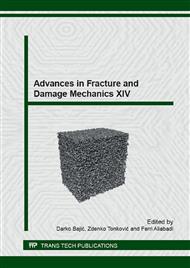p.37
p.41
p.45
p.49
p.53
p.57
p.61
p.65
p.69
Mixed-Mode Crack Patterns in Ordinary State-Based Peridynamics
Abstract:
A new nonlocal theory of continuum, called Peridynamics, was introduced in 2000. While the classical theory of solid mechanics employs spatial derivatives in order to solve the motion equation and consequently requires the derivability of the displacement field, Peridynamics employs an integral formulation of the equation of motion which leads to the possibility to analyze structures without specific techniques whenever discontinuities, such as cracks or inhomogeneities, are involved. Peridynamics has proven to be able to handle several phenomena concerning crack propagation. There are two variants of the theory, bond-based and state-based. The former is a particular case of the latter, which can also be found in two versions, the ordinary, in which the interaction force between two nodes is aligned with their current relative position, and the non-ordinary, in which interaction forces can have different directions and classical models can be directly introduced in the formulation, even though in this variant numerical integration problems arise (spurious mode deformation). In this study, fracture patterns for mixed-mode crack propagation cases are investigated while varying two fundamental parameters of Peridynamics, the maximum length of interaction, called horizon, and the ratio between the grid spacing and the horizon, called m-ratio. An ordinary state-based Peridynamics formulation is adopted and numerical results are compared with experimental evidences.
Info:
Periodical:
Pages:
53-56
Citation:
Online since:
September 2015
Authors:
Keywords:
Price:
Сopyright:
© 2016 Trans Tech Publications Ltd. All Rights Reserved
Share:
Citation:


